Improving fertilizer nitrogen use efficiency in summer sorghum
Author: Mike Bell (University of Queensland), David Lester (Qld Dept of Agriculture, Fisheries and Forestry) Peter Grace (Queensland University of Technology) | Date: 26 Aug 2014
Take home message
Nitrogen fertiliser costs dominate the fertilizer budgets of cereal cropping systems across the northern region. However there is uncertainty around N fertilizer decisions (rate, placement) and the variable seasonal conditions in recent years have also raised questions about the returns on investment in N fertilizer.
Our research is highlighting the importance of pre-season soil testing to quantify profile mineral N reserves and subsequently adjust fertilizer N rates, especially after unusually wet seasonal conditions resulted in some large gaseous N losses by denitrification. However uncertainty about yield targets and seasonal forecasts has caused growers to re-evaluate fertilizer strategies. Attempts to delay fertilizer N decisions until planting, or even in crop, to minimize risk have not always been successful due to variable in-season rainfall.
Research is currently attempting to better define the critical soil mineral N for different target yields across the region, while also quantifying fertilizer N recovery by the crop and export in harvested grain. The effect of N fertilizer application time (pre-planting, at planting and in crop/side dressing) and product choice (urea alone or in varying formulations designed to delay nitrification and slow the release of mineral N) are being examined for their effect on N use efficiency.
Strategies that delay N fertilizer application/release to better match crop demand can be effective in improving crop N uptake and reducing denitrification losses, but have not yet been shown to significantly improve fertilizer N use efficiency. Cropping systems where pasture leys or grain legumes have improved mineralisable N reserves have allowed reduced fertilizer N rates, improved fertilizer N recovery and reduced denitrification losses.
Background - fertilizer N responses in sorghum
Investments in fertilizer nitrogen (N) in northern cropping systems already dominate fertilizer budgets which themselves represent a significant proportion (up to40%) of variable costs. This trend will continue as soil organic matter (and N) reserves continue to decline, along with mineral nutrients like phosphorus and potassium, and the reliance on nutrients supplied from fertilizers increases.
While fertilizer N decisions for wheat are based on an extensive (if somewhat dated) research program conducted in northern grains soils, there have been considerably fewer trials conducted on summer sorghum. Historical trial data that have been captured in the Better Fertilizer Decisions for Cropping Interrogator database (Watmuff et al. 2013) show a variety of sampling depths, measurement units and soil test methods which have further limited the number of trials that can be used to define critical soil test values that indicate likely fertilizer N responsiveness. The conduct of fertilizer N response trials under a variety of seasonal conditions and on soil types with differing soil organic matter contents and rotation histories will help to overcome this limitation.
Once the need to apply fertilizer N has been determined from preplant soil tests, the crop N demand needs to be quantified by setting targets for yield and protein content. Given the lack of price signals for grain protein in sorghum, we can use a default 10% protein (1.6%N) as the target at which crop yields are not limited by N availability. Similarly, we can assume that approximately half the crop N is removed in grain and the other half is retained in residues and roots. Using this information we can determine a crop nitrogen budget for our projected yield target.
Eg. Grain N requirement Yield target = 5 t/ha at 1.6%N = 80 kg N/ha
Crop N requirement to grow that grain yield = 2 * 80 = 160 kg N/ha.
Fertiliser N demand is then a simple calculation of the crop requirement minus the profile mineral N to known crop rooting depth (60cm, 90cm or 120cm, depending on soil characteristics etc) minus an allowance for in-season mineralization of N from crop residues and soil organic matter. Sounds easy, but in practice there are a lot of factors that can influence the effectiveness (or otherwise) of this approach. The most obvious are –
- Seasonal yield potential either greater than or less than expected, so calculated fertilizer N requirement either under or over-estimated.
- Seasonal conditions that result in poor recovery of soil or fertilizer N by the crop
- In-season mineralization estimates under or over-estimated, due to variations in lability of organic N reserves or seasonal conditions
New research on fertilizer N responses in sorghum (UQ00066, DAF00004-05):
Current research in projects supported by GRDC and the Federal Dept of Agriculture under the NANORP (National Nitrous Oxide Research Program) is attempting to fill the N fertilizer trial deficit for sorghum to both (i) better define the relationship between preplant soil test and fertilizer N requirements, and (ii) quantify the efficiency of crop recovery and conversion of fertilizer N into grain yield for different fertilizer products, management strategies, crop rotations and seasonal conditions. Results from this program aim to improve fertilizer N management decisions and provide information to develop more efficient N management practices to reduce costs and off site impacts as well as improve productivity and sustainability.
Soil tests to indicate fertilizer N requirement
The first 2 summer crop seasons provided stark contrasts in terms of seasonal conditions, yield potentials and agronomic practices (especially row spacing). In some ways this has proved a useful illustration of the impact of yield potential on the critical soil test value for determining N fertilizer applications. In higher yielding seasons (4-7 t/ha), the critical profile (0-90cm) soil test N content above which fertiliser responses would be unlikely seems to be in the vicinity of 120 kg N/ha. For crops with lower yield potentials the critical value is as yet poorly defined, but would seem to be significantly less that that in the high yielding years.
There needs to be a fair few more trials to get a clear handle on these relationships, and to distinguish between different rotation histories/soil organic matter contents. One example in the dataset below (ringed with the dotted line) shows a site doubled cropped after a winter legume crop, compared to the other very low N sites that were following cereals in short fallow or double crop situations. Clearly the legume has provided a significant in-season N mineralization contribution to the crop N uptake and yield (50% of maximum yield compared to 20-30% without legumes), but this was not reflected in the soil test pre-sowing.
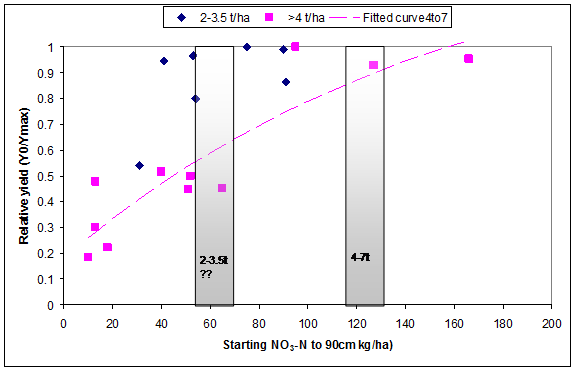
Figure 1. Relative grain yield (% Ymax) of grain sorghum as a function of preplant nitrate-N in the top 90cm of the soil profile. Two crop categories are shown based on the trial maximum grain yield with fertilizer N applied (i.e. Ymax), with a site with a legume crop history identified.
Fate of applied N
The decision to apply N fertilizer is only the first part of the N puzzle, with the next questions relating to the required N rate and the application strategy (ie. preplant, in crop or a mix of both). While it is easy to look at results from an individual trial in a single growing season, the complexity arises when we look at the same sorts of trials in contrasting seasons and soil types – even when yield potentials are similar. The key factor in all this is how much of the applied N was actually taken up by the crop, rather than applied as fertilizer and what was the fate of any residual N – either in the stubble or in the soil.
Crop N recovery has been monitored in a number of trials over the last two summer crop seasons, with the varying results illustrated for three contrasting sites and seasonal conditions in the 2013/14 season (Fig. 2). Crop uptake of fertilizer N ranged from nothing (at a rainfed site at Bongeen, with no in-season rainfall until near physiological maturity), to 45-55% at Kingsthorpe (rain/irrigation at planting, and falls mid-season and near maturity) and ~100% at Kingaroy (low starting N and frequent small rainfall/irrigation events). The fate of applied N not recovered by the crop is variable, with most of the applied N still in the soil profile as NO3-N at Bongeen (Plate 1), but no significant residual soil mineral N (data not shown) but significant in-season denitrification losses recorded at Kingsthorpe (Figures 3 and 4).
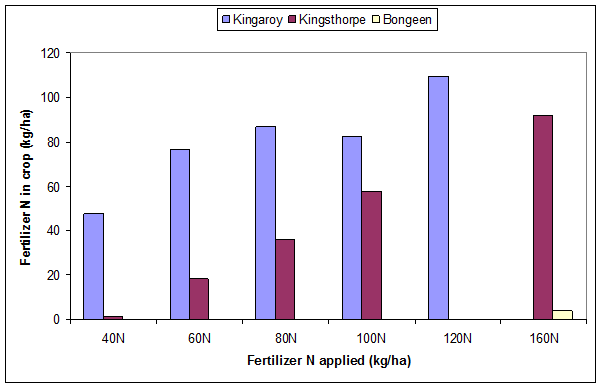
Figure 2.Crop uptake of fertilizer N (applied as urea at sowing) in sorghum crops grown under contrasting moisture conditions in 2013/14.
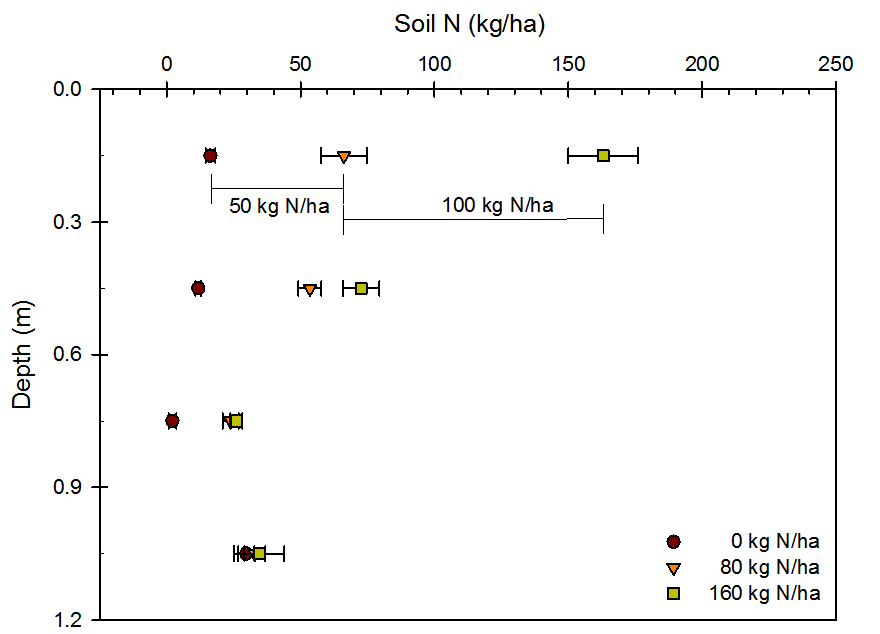
Figure 3. Residual NO3-N in the soil profile after harvest at Bongeen in June 2014. Data are shown from the 0N, 80N and 160N treatments, with cumulative differences (kg N/ha) between the 0N and 80N, and between the 80N and 160N treatments, shown.
The recent wet seasons have re-emphasised the importance of gaseous N losses through processes such as denitrification, with losses of soil NO3-N accumulated during a fallow (or residual after a poor crop, such as at Bongeen) that can be quite large after significant rainfall events. This was illustrated at the long term IPL site at Colonsay, when >80 kg N/ha was lost during the 2010/11 summer wet season. Similarly large losses were recorded during the sorghum cropping season in 2012/13 at both Kupunn and Kingsthorpe (Fig. 5), with approx 50% of the applied N in the 80 and 160N rates not found in soil or plant pools after harvest.

Figure 4. Nitrous oxide emissions for the 0N, 80N and 160N treatments at the Kingsthorpe site in 2013/14. Emissions are shown as both daily fluxes and cumulative totals across the growing season. A contrast between urea and Entec® (urea with a nitrification inhibitor designed to reduce denitrification losses) is shown at the 160N rate.
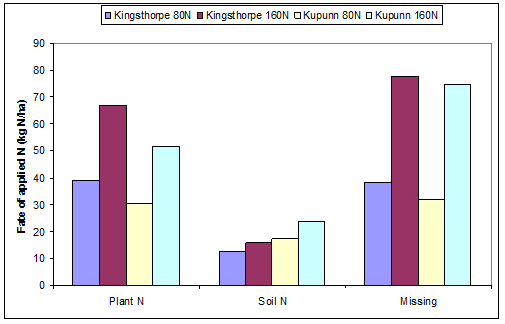
Figure 5. Fate of N fertilizer applied at 80 or 160 kg N/ha determined after harvest of the 2012/13 sorghum crops at Kupunn and Kingsthorpe. Results were obtained using 15N-labelled urea.
Agronomic efficiency (kg grain/kg applied N fertilizer)
The Agronomic Efficiency (AE) is highest at low N application rates and with low starting soil N status (ie. 13-18 kg NO3-N/ha compared to 50-65 kg N/ha: Fig. 6), but decreases with increasing N rate. In these examples, the sites with the lowest starting soil N (15-18 kg NO3-N/ha to 90cm) showed AE of 50-65 kg grain/kg N applied at low rates, with the marginal return on additional N applications falling below 20 kg grain/kg N at rates in excess of 90-100 kg N/ha in these high yielding crops. In contrast, the AE in sites with higher starting N (50-65 kg NO3-/ha to 90cm) began lower (25-30 kg N/ha) and the marginal return on additional N applications dropped below 20 kg N/ha at rates between 50-60 kg N/ha. The economic decision on optimum rate in both situations will be influenced by the relative values of fertilizer N and grain.
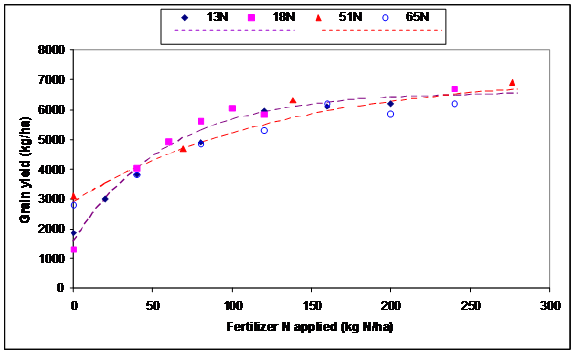
Figure 6. Sorghum grain yield in response to N application at 4 sites in Qld and NSW with similar potential yields but different starting soil N.
Where to from here?
The current focus of our work is on improving both the decisions around deciding to apply N fertilizer and on improving the use of that applied N to both be accumulated in the crop and produce an economic grain yield response. We have consistently observed reduced nitrous oxide emissions resulting from the use of products that slow the accumulation of NO3-N in soil (eg. Entec®, as shown in Fig 4) or that better synchronizes that release with crop N demand (eg. controlled release N fertilizers). We are now focussing work on determining if use of these (currently) more expensive N forms can result in lower (and thus more economic) fertilizer N application rates.
The other observation concerns the value of soil organic N reserves, whether from resident humic pools or from legumes in the crop rotation. Both result in lower fertilizer N application rates, less potential for gaseous N losses and greater chances of improved fertilizer N use efficiency.
Acknowledgements
These projects are funded by the Federal Department of Agriculture and GRDC, with co-investment from UQ, QUT, DAFF Qld and NSW DPI. Special thanks to Gary Harch, Lawrie Smith, Peter Want, Peter Forman, Matt Gardner, Max De Antoni Migliorati and David Rowlings for field and laboratory support, and for collaborating growers for hosting trials on their properties.
Contact details
Mike Bell
Queensland Alliance for Agriculture and Food Innovation,
University of Qld
Ph: 07 4160 0730
Email: m.bell4@uq.edu.au
David Lester
Agri-Science Queensland
Dept of Agriculture, Fisheries and Forestry
Ph: 07 4639 8886
Peter Grace
Queensland University of Technology, Brisbane
Ph: 07 3138 9283
Email: pr.grace@qut.edu.au
® Registered trademark
GRDC Project Code: UQ00066 and DAF00004-05,
Was this page helpful?
YOUR FEEDBACK
